Cumae
Cumae ( Italian Cuma , Greek Κύμη Kyme ) was an ancient city in the Italian region of Campania, northwest of Naples (municipality of Bacoli ). The name is probably derived from the Greek city of Kyme on Evia , but possibly also from the Greek word κῦμα kyma "wave" (alluding to the undulating silhouette of the peninsula on which the place is located).
history
Cumae was founded around 740 BC. Founded by Greek colonists from Chalkis and Eretria , which had previously been in existence since 770 BC. BC on the island of Ischia off the mainland the place Pithekoussai ( Greek Πιθηκοῦσσαι Pithekoussai "monkey island"), and was thus the first Greek apoikie on the Italian mainland. Kyme was organized as a polis . Later it founded its own planting cities: Dikaiarcheia (Puteoli, Pozzuoli ) and Neapolis ( Naples ).
Cumae became famous as the place where the Sibyl of Cumae prophesied, her alleged cave is now a tourist attraction. It is located in a room to which a 131 meter long corridor leads, which has been cut with many branches into the southern slope of the castle hill. The oldest part of this complex dates from the 6th or 5th century BC. In addition, Cumae is the place where the influential early Christian work The Shepherd of Hermas is said to have been inspired by visions.
Kyme / Cumae experienced its heyday between 700 and 500 BC. When it was under the tyrant Aristodemus in the years 524 and 504 BC. The Etruscans fended off and they in the year 474 BC. BC with the combined fleets of Cumae and Syracuse under Hieron I struck again in the battle of Cumae .
Around 420 BC In BC Kyme / Cumae was conquered by the Samnites , took over Oscar customs and lost its Greek character. Since the end of the First Samnite War in 341 BC It was ruled by the Roman Republic since 334 BC. BC Cumae had limited rights as a Roman municipium . After Cumae lost its function as a port to Puteoli during the imperial era, the city fell silent, which was now only important as the seat of the Sibyl.
archeology
Excavations brought a temple of Zeus from the late 6th century BC to the Acropolis . BC (which was rededicated in a basilica in the 5th century AD ) and below the castle a temple of Apollo from the 5th century BC BC, which was renewed at the time of Augustus and also rededicated to a basilica in the 5th century AD. Augustus is also responsible for the construction of thermal baths and an amphitheater, as well as the expansion of the port of Misenum east of the city with the Portus Iulius realized by Lucius Cocceius Auctus . There was an Isis temple near the harbor , in which there were Egyptian statues.
Individual evidence
- ↑ Titus Livius 8, 22, 5-6: Cumani Chalcide Euboica originem trahunt. Classe, qua advecti ab domo fuerant, multum in ora maris eius quod accolunt potuere, primo <in> insulas Aenariam et Pithecusas egressi, deinde in continentem ausi sedes transfere. “The Cumaer come from the Euboean Chalcis. Thanks to the fleet with which they had come here from home, they wielded a great deal of power along the coast of the sea on which they lived. First they went to the islands of Ainaria and Pithekoussai, later they dared to move their homes to the mainland. "
- ↑ Paollo Gatto: Se L'egitto dei romani é la costa allesanndrina , in: Federico Poole (editor): Il Nilo a Pompei , Turin ISBN 9788857011066 , p. 86
literature
- Amedeo Maiuri : The Antiquities of the Phlegraean Fields. From the tomb of Virgil to the cave of Cumae (= guide through the museums and art monuments of Italy. Vol. 32). Istituto Poligrafico dello Stato, Roma 1968. 5. verb. 1983 edition.
- Paolo Caputo among others: Cuma e il suo Parco Archeologico. Un territorio e le sue testimonianze . Bardi, Roma 1996.
Web links
Coordinates: 40 ° 50 ′ 31 ″ N , 14 ° 3 ′ 21 ″ E
